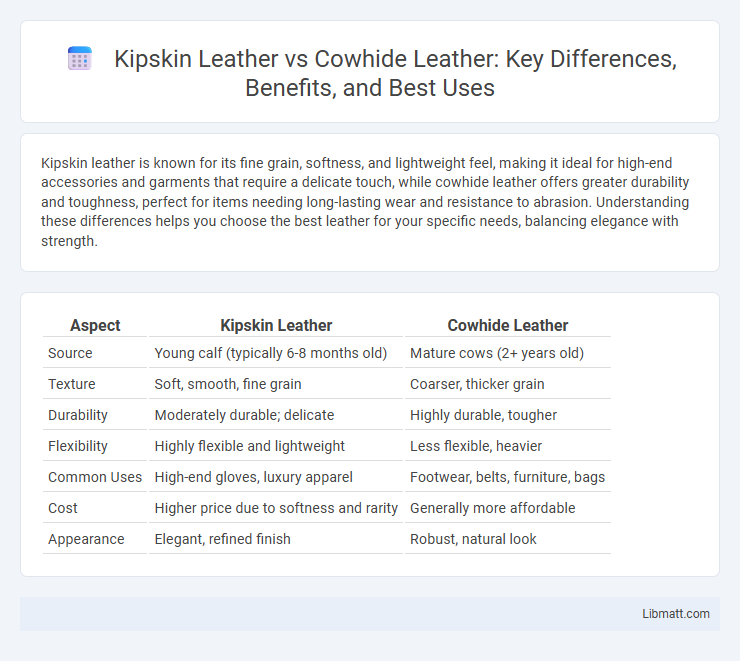Kipskin leather is known for its fine grain, softness, and lightweight feel, making it ideal for high-end accessories and garments that require a delicate touch, while cowhide leather offers greater durability and toughness, perfect for items needing long-lasting wear and resistance to abrasion. Understanding these differences helps you choose the best leather for your specific needs, balancing elegance with strength.
Table of Comparison
| Aspect | Kipskin Leather | Cowhide Leather |
|---|---|---|
| Source | Young calf (typically 6-8 months old) | Mature cows (2+ years old) |
| Texture | Soft, smooth, fine grain | Coarser, thicker grain |
| Durability | Moderately durable; delicate | Highly durable, tougher |
| Flexibility | Highly flexible and lightweight | Less flexible, heavier |
| Common Uses | High-end gloves, luxury apparel | Footwear, belts, furniture, bags |
| Cost | Higher price due to softness and rarity | Generally more affordable |
| Appearance | Elegant, refined finish | Robust, natural look |
Introduction to Kipskin and Cowhide Leather
Kipskin leather, derived from young domestic cows, offers a finer grain and softer texture compared to traditional cowhide leather, which comes from mature cattle and features a coarser, more durable surface. Both types are prized for their strength and versatility in fashion and upholstery, with Kipskin often chosen for luxury goods due to its smooth finish and increased flexibility. Your selection between Kipskin and cowhide leather depends on the desired balance between softness and rugged durability.
What is Kipskin Leather?
Kipskin leather is derived from the hide of young calves, specifically those between six to nine months old, offering a finer grain and softer texture compared to traditional cowhide leather. It features a dense fiber structure that enhances durability while maintaining flexibility, making it ideal for luxury goods such as handbags and high-end footwear. The refined finish and higher breathability of kipskin leather distinguish it from the coarser, thicker cowhide, which is typically sourced from mature cattle and used in rugged applications like work boots and upholstery.
What is Cowhide Leather?
Cowhide leather is a durable and versatile material derived from the outer layer of a cow's hide, renowned for its strength and ability to develop a rich patina over time. Compared to kip skin leather, which comes from younger calves and tends to be softer and more supple, cowhide offers greater resilience and is commonly used in heavy-duty products like jackets, furniture, and footwear. Your choice between cowhide and kip skin leather depends on the desired texture, durability, and application of the leather goods.
Origin and Sourcing Differences
Kipskin leather is sourced from the hides of young calves, primarily in regions like Italy and France, known for their high-quality livestock farming. Cowhide leather originates from mature cows, with sourcing concentrated globally, especially in countries like the United States, Brazil, and India. The key difference lies in the age of the animal, with kipskin offering a finer grain and smoother texture due to the younger age of the calf compared to the thicker and more durable cowhide.
Texture and Appearance Comparison
Kipskin leather features a fine, smooth texture with a subtle grain pattern that offers a sleek, polished appearance, making it ideal for luxury accessories and high-end footwear. In contrast, cowhide leather exhibits a coarser texture with pronounced grain and natural markings, providing a rugged, durable look suited for casual and heavy-duty items. The refined texture of kipskin enhances elegance, while cowhide's robust appearance adds character and toughness.
Durability and Strength Face-Off
Kipskin leather, derived from young cattle, offers a finer grain and softer texture but is less durable compared to cowhide leather, which comes from mature cattle and boasts superior strength and toughness. Cowhide's dense fiber structure ensures resistance to wear, stretching, and punctures, making it ideal for heavy-use items like jackets and saddles. Your choice depends on whether you prioritize the luxurious feel of kipskin or the robust longevity of traditional cowhide.
Flexibility and Ease of Crafting
Kipskin leather offers superior flexibility compared to cowhide leather, making it ideal for intricate crafting and detailed design work. Its finer grain and softer texture allow artisans to achieve precise cuts and smooth curves with ease. Your creative projects benefit from Kipskin's adaptability, ensuring a high-quality finish without compromising durability.
Common Uses of Kipskin vs Cowhide
Kipskin leather, known for its fine grain and softness, is commonly used in the production of high-end gloves, wallets, and small accessories requiring a lightweight and supple material. Cowhide leather, prized for its durability and toughness, is widely utilized in making heavy-duty goods such as jackets, saddles, footwear, and large upholstery items. The choice between kipskin and cowhide often hinges on the desired balance between flexibility and ruggedness in leather products.
Price and Value Analysis
Kipskin leather generally commands a higher price than cowhide due to its finer grain, durability, and luxurious texture, making it a preferred choice for premium wallets and accessories. Cowhide leather offers excellent value through its affordability and versatility, suitable for a wide range of leather products without compromising quality. The price difference aligns with durability metrics and specific use-cases, where kipskin's long-lasting nature justifies its premium cost in luxury markets.
Which Leather Should You Choose?
Kipskin leather offers a smoother texture and greater durability compared to cowhide, making it ideal for high-end fashion items and accessories that require a luxurious finish. Cowhide leather is thicker and more rugged, providing excellent resistance to wear and ideal for heavy-duty products like jackets, boots, and furniture upholstery. For those prioritizing softness and fine grain, Kipskin is the preferred choice, while cowhide suits users needing robust, long-lasting leather.
Kipskin leather vs cowhide leather Infographic

 libmatt.com
libmatt.com